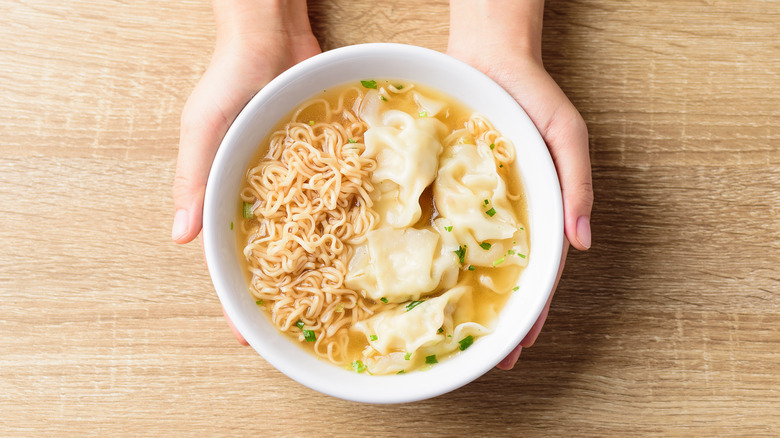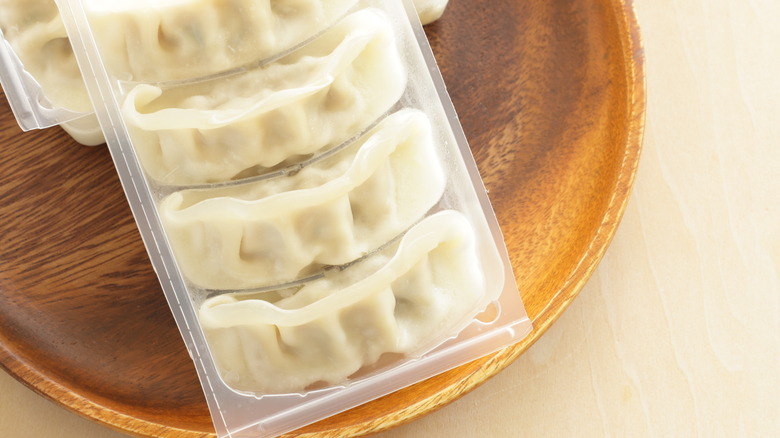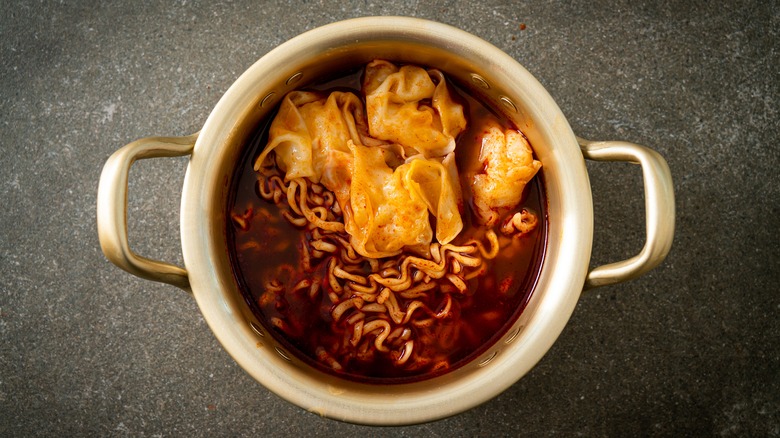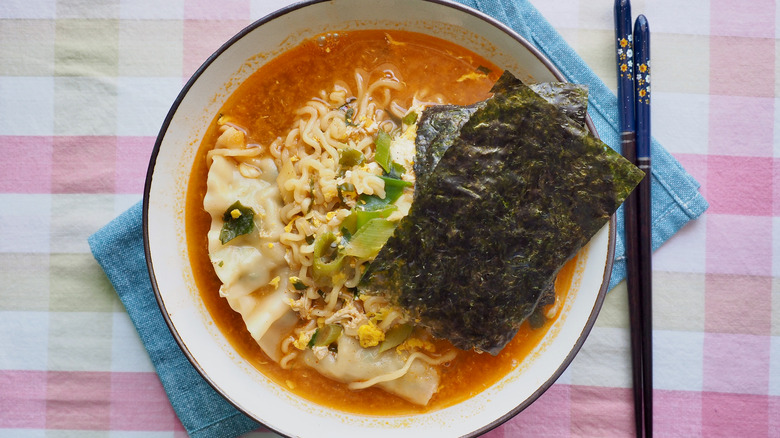Elevate Your Bowl Of Instant Ramen With Frozen Dumplings
As convenient as instant ramen is, it's never quite filling enough to be a full meal — even if you're cooking with a proper packet on the stovetop instead of just having a single cup, you've probably found yourself still a little peckish by the end. While there are a ton of unconventional ingredients that'll seriously upgrade your instant ramen, sometimes you just won't be in the mood for extra ingredient prep just to make things a little more filling. The simplest solution for a quick and satisfying meal? Toss in some of the frozen instant dumplings you've got in the freezer for an instantly filling dumpling-ramen stew.
It's a great way to add some substance to your ramen without extending the cooking time. And you're not just dropping in extra food just for the sake of it — because of how well-seasoned instant frozen dumplings are, you'll most likely be elevating your ramen with a whole new layer of savory flavors to complement the broth. Sure, it's not the healthiest meal to have in terms of sodium content, but who's really counting? Whether you're running short on time and energy to cook a full meal, or just craving an explosion of umami on a cheat night, an instant ramen with dumplings might just be exactly what you're looking for.
What dumplings are best for instant ramen?
While most instant dumpling to instant ramen combinations will be packed with umami, there are a few things to consider to avoid unpleasant surprises and really elevate your experience. While it largely depends on personal taste, some combinations just clash in unappetizing ways that might leave you disappointed. It's hard to predict what will taste good or bad before trying it, of course, but a good rule of thumb to gauge by is that stronger flavors of ramen accommodate more kinds of dumplings, while stronger flavors of dumplings are more restrictive in how complementary they can be.
For example, you should really be careful about adding kimchi dumplings to instant ramen that isn't the spicy Korean type. On the same token, spicy Korean ramen is strong enough to accommodate and incorporate most flavors of dumplings by overpowering any notes that might be incompatible. When it comes to overall versatility, mild and basic dumplings like gyoza and Korean mul-mandu are excellent additions to any kind of ramen by virtue of having tasty yet generic savory notes that soak up and complement whatever flavor of broth they're put into.
How to add the frozen dumplings to the ramen
One important thing to emphasize is that all of this only applies to frozen instant dumplings, which have been fully cooked before being packaged. To avoid giving yourself food poisoning with raw dumpling filling, make sure you check the packaging for whether or not the dumplings come pre-cooked.
Learning the correct timing to drop in your instant dumplings to your instant ramen is something of an inexact science. As a general rule, the dumplings should be cooked in the ramen broth for at least as long as the boiling instructions on its packaging advise. Depending on the brand of dumpling and/or ramen, this can mean anything from adding the dumplings to the unboiled water from the very beginning, adding the dumplings with the broth powder and pre-boiling for a few minutes before adding the noodles, or adding the dumplings and noodles at the same time.
If your dumpling packaging doesn't have timing instructions — or they're in a language you can't read — a good starting point is to add the frozen dumplings at the very beginning to ensure that they're heated up all the way through by the end. Alternatively, you can thaw the dumplings beforehand and add them at the same time as the noodles. You can adjust the timing to your personal preference after seeing how they turn out. Keep in mind, however, that very small dumplings don't take nearly as long to heat up from frozen and should be added after the water starts boiling, at the earliest.
Other things to consider
An important thing to note is that some kinds of dumplings get extremely mushy and release a lot of murky starch into your ramen broth. It might take a bit of trial and error, but it's important to make note of which kinds of dumplings perform well in instant ramen, and which kinds just need to be boiled separately so you can dispose of the dumpling water.
However, if you really like the taste of a dumpling that makes ramen broth murky, you can circumvent the issue by keeping the dumplings out of water entirely. Most, if not all instant dumplings will have stovetop boiling as well as steaming and microwaving instructions. Don't want to bust out an extra bowl or pot to microwave or steam the dumplings? No problem: The one-pot secret to adding steamed dumplings to your instant ramen only involves balancing a pair of heat-safe chopsticks on top of your ramen pot. All you have to do is balance your dumplings on top of the chopsticks, cover the entire thing with a pot lid so that the dumplings are getting a nice steam bath before the vapor escapes out the sides, et voilà — instant ramen and steamed dumplings done with one pot.
The caveat is that you'll want the chopsticks to have flat edges or sides to minimize any rolling or slipping. Additionally, not all dumplings are shaped to accommodate this kind of minimalistic steaming — gyoza are usually long and sturdy enough to be perfect for it, but your mileage may severely vary with smaller or more rounded kinds of dumplings.



